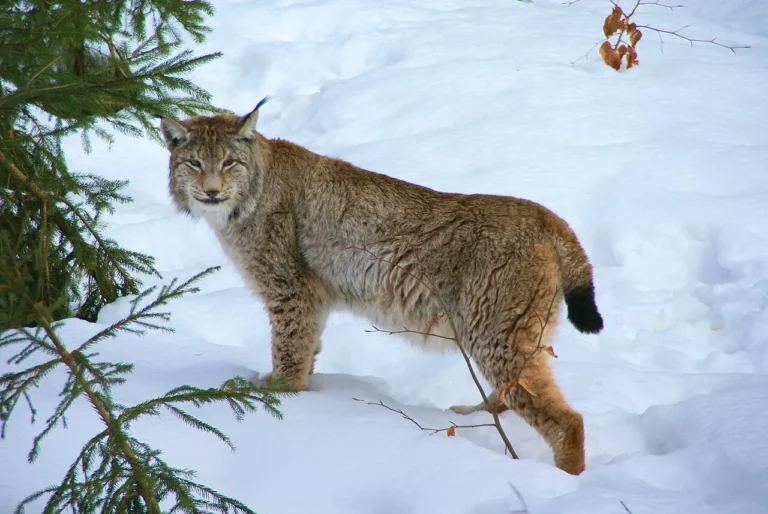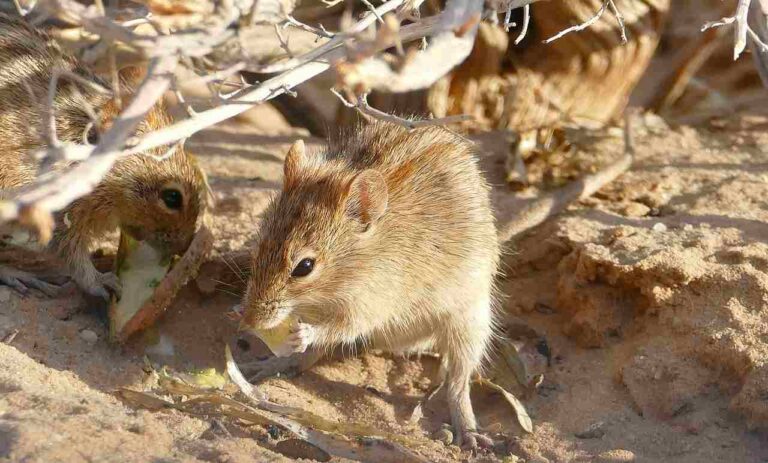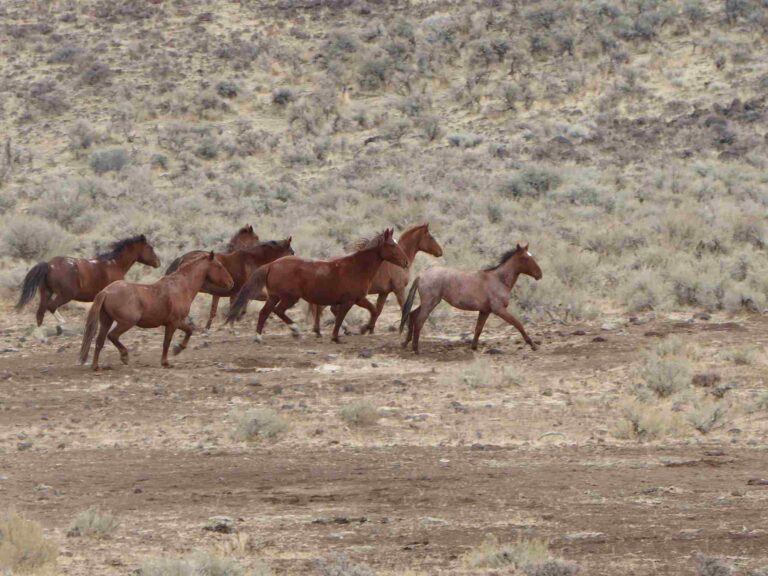What Do Rabbits Eat in the Winter? Rabbit Winter Diet Discussed
Things rabbits eat in the winter include twigs, buds, bark, pine needles, woody shrubbery; and other forms of plant matter that are available in the absence of their preferred food materials like fresh foliage and fruits.
What Do Wild Rabbits Eat in the Winter?
1. Buds
Buds are an important food source for wild rabbits during the winter months. These small, undeveloped shoots contain essential nutrients that rabbits need to survive in cold weather. Rabbits have a keen sense of smell and can easily locate buds on trees and shrubs.
During the winter, when other food sources are scarce, rabbits rely on buds as a primary source of nutrition. They are rich in vitamins, minerals, and antioxidants, which help to boost the rabbit’s immune system and keep them healthy during the harsh winter conditions.
Rabbits are selective eaters and will choose buds from a variety of plants. They particularly enjoy the buds of fruit trees such as apple, cherry, and pear. Other preferred bud sources include maple, birch, and willow trees. These buds provide rabbits with a diverse range of nutrients and flavors.
To ensure that wild rabbits have access to buds during the winter, it is important to preserve natural habitats and avoid excessive pruning or trimming of trees and shrubs. By maintaining a healthy ecosystem, we can help provide rabbits with a sustainable food source.
In addition to preserving natural habitats, planting cold-tolerant shrubs and trees can also benefit rabbits during the winter. These plants produce buds that can withstand colder temperatures and provide rabbits with a reliable food source throughout the season.
2. Twigs
Twigs are another important food source for wild rabbits during the winter months. These small branches provide rabbits with essential nutrients and fiber that are necessary for their survival in cold weather.
Rabbits have a natural instinct to chew on twigs, which helps to wear down their constantly growing teeth. This is especially important during the winter when other food sources are scarce. Twigs also provide rabbits with hydration, as they contain a small amount of moisture.
Rabbits are selective eaters and will choose twigs from a variety of plants. They particularly enjoy the twigs of shrubs such as raspberry, blackberry, and rose. These twigs not only provide rabbits with necessary nutrients but also offer them a source of hydration.
To ensure that wild rabbits have access to twigs during the winter, it is important to avoid excessive pruning or trimming of shrubs. By allowing shrubs to grow naturally and providing rabbits with a variety of twigs to choose from, we can help support their nutritional needs.
In addition to preserving natural habitats, collecting fallen branches and twigs can also benefit rabbits during the winter. Fallen branches and twigs can be scattered in areas where rabbits are known to frequent, providing them with an additional food source.
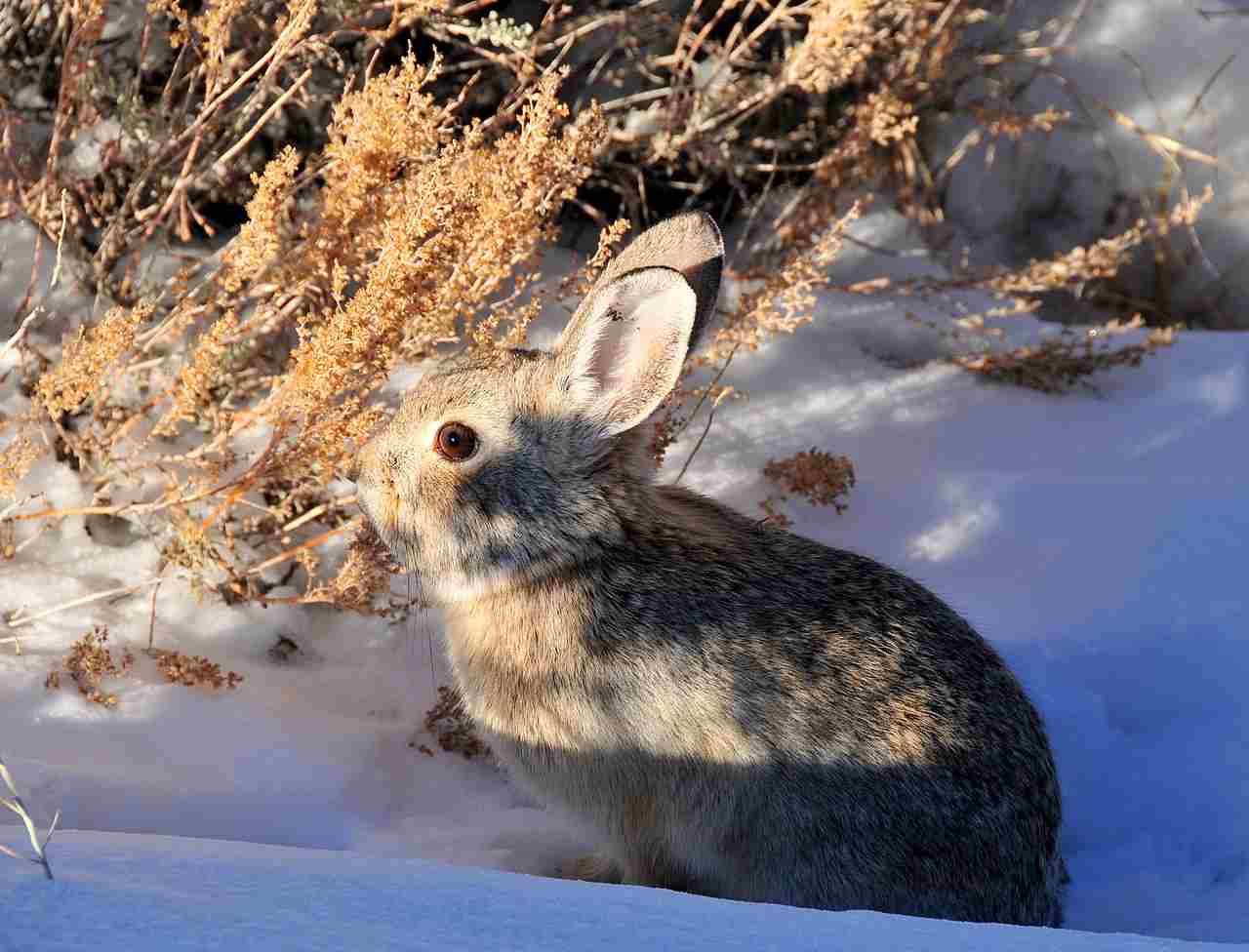
3. Tree Bark
Tree bark is another important food source for wild rabbits during the winter months. Despite its tough and fibrous texture, rabbits have adapted to consume tree bark as a means of survival when other food options are limited.
Rabbits primarily target the bark of young trees and shrubs, as it is more tender and easier to chew. They use their sharp incisors to strip away the outer layers of bark, revealing the softer inner layers that contain vital nutrients. This behavior not only provides rabbits with sustenance but also helps to wear down their continuously growing teeth.
In terms of nutrition, tree bark is rich in fiber, which aids in digestion and helps maintain a healthy gut. It also contains essential minerals such as calcium and phosphorus, which are crucial for maintaining strong bones and teeth. Additionally, tree bark can provide rabbits with hydration, as it retains a small amount of moisture.
To support wild rabbits’ access to tree bark during the winter, it is important to preserve natural habitats and avoid excessive tree pruning. By allowing trees and shrubs to grow naturally, rabbits can find a variety of bark options to meet their nutritional needs. Fallen branches and twigs can also be collected and scattered in areas frequented by rabbits, providing them with additional sources of bark.
4. Pine Needles
Pine needles are another important food source consumed by wild rabbits in the winter. Despite their prickly appearance, rabbits have adapted to utilize pine needles as a source of nutrition when other food options are scarce.
Pine needles provide rabbits with essential nutrients such as vitamins A and C, as well as small amounts of calcium and phosphorus. These nutrients are crucial for maintaining the overall health and well-being of rabbits, especially during the winter months when their immune systems may be more vulnerable.
In addition to their nutritional value, pine needles also serve as a source of hydration for rabbits. Although they may not contain as much moisture as other food sources, pine needles retain a small amount of water that can help rabbits stay hydrated in dry winter conditions.
To ensure that wild rabbits have access to pine needles during the winter, it is important to preserve natural habitats where pine trees grow. Avoid excessive pruning or removal of pine trees, as this can limit the availability of pine needles for rabbits. Additionally, fallen pine branches and needles can be collected and scattered in areas frequented by rabbits, providing them with additional sources of this important food.
How to Help Wild Rabbits in Winter?
Ways to help wild rabbits in winter include minimal lawn mowing, cultivation of cold-tolerant shrubbery, hay provision, insulated shelters, collecting fallen branches and twigs, as well as providing fruits and pellets.
1. Minimal Lawn Mowing
Minimal lawn mowing is a simple yet effective way to help wild rabbits in winter. By leaving patches of tall grass and vegetation, you can provide them with both shelter and food.
During the winter months, rabbits rely on the cover of tall grass and vegetation to protect themselves from harsh weather conditions and predators. By minimizing lawn mowing, you create areas where rabbits can seek refuge and stay warm. These patches of tall grass also provide a natural food source for rabbits, as they can nibble on the grass blades and find seeds and insects hidden within.
In addition to providing shelter and food, minimal lawn mowing helps to maintain the natural habitat of wild rabbits. It allows them to continue their natural behaviors, such as burrowing and foraging, without disruption. By preserving their habitat, you are contributing to the overall well-being and survival of wild rabbit populations.
To implement minimal lawn mowing, you can designate specific areas in your yard where you allow the grass to grow longer. These areas can be strategically placed near shrubs or trees, providing additional cover for the rabbits. By doing so, you create a mini wildlife sanctuary within your own property, supporting the local ecosystem.
2. Cultivation of Cold-Tolerant Shrubbery
Cultivating cold-tolerant shrubbery is another effective way to help wild rabbits in winter. These shrubs provide physical barriers from cold winds and snow, creating a more sheltered environment for the rabbits. Additionally, certain types of shrubs can serve as a natural food source for rabbits during the winter months.
When selecting shrubs for your yard, opt for varieties that are hardy and can withstand the harsh winter conditions. Examples of cold-tolerant shrubs include juniper, holly, and winterberry. These shrubs not only provide cover for the rabbits but also produce berries or fruits that rabbits can eat.
By planting cold-tolerant shrubs strategically around your property, you create a habitat that is both inviting and beneficial for wild rabbits. The shrubs offer protection from the elements and provide a source of food when other vegetation is scarce. This encourages rabbits to stay in the area and reduces their need to venture into more dangerous territory in search of food and shelter.
To ensure the success of your shrubbery cultivation, it’s important to properly care for the plants. This includes regular watering, pruning, and protection from pests. By maintaining healthy shrubs, you create a sustainable food and shelter source for wild rabbits throughout the winter season.
3. Hay Provision
Hay provision is arguably the best food for wild rabbits during the winter months. Rabbits are accustomed to consuming hay as part of their natural diet, and it provides them with essential nutrients and fiber. Providing hay for wild rabbits is not only a way to help them survive the winter, but it also ensures that they have access to a familiar and nutritious food source.
When offering hay to wild rabbits, it’s important to choose high-quality hay that is free from mold or dust. Timothy hay is a popular choice as it is readily available and widely accepted by rabbits. Place the hay in a sheltered area, such as under a shrub or in an insulated shelter, to protect it from the elements and keep it dry.
To attract rabbits to the hay provision, scatter some hay around the area to entice them. This will help them discover the food source and encourage them to return regularly. It’s also beneficial to provide fresh water nearby, as rabbits need to stay hydrated even in the winter.
By offering hay as a food option, you not only provide rabbits with a nutritious meal but also help them conserve energy. Foraging for food in the winter can be challenging, and hay provision reduces the need for rabbits to search for scarce vegetation. This allows them to conserve energy and stay warm during the colder months.
4. Insulated Shelters
Insulated shelters are a crucial way to help rabbits survive the winter. These shelters, such as raised wooden containers filled with straw, serve a dual purpose as both feeders and shelters. They provide rabbits with a safe and protected space where they can seek refuge from the harsh winter weather.
The insulation provided by these shelters helps to keep the rabbits warm during the colder months. The raised design prevents the shelters from becoming damp or flooded, ensuring that the rabbits stay dry and comfortable. The straw inside the shelters acts as additional insulation, providing an extra layer of warmth.
In addition to providing protection from the elements, insulated shelters also serve as a reliable food source for rabbits. By placing hay or other suitable food inside the shelters, you can ensure that the rabbits have easy access to nourishment. This reduces the need for them to venture out in search of food, minimizing their exposure to predators and conserving their energy.
Creating insulated shelters is a simple and effective way to support rabbits in winter. They can be easily constructed using materials like wood and straw, and can be placed strategically in areas where rabbits are known to frequent. By providing these shelters, you are offering rabbits a safe haven and a consistent source of food, helping them to survive the challenges of winter.
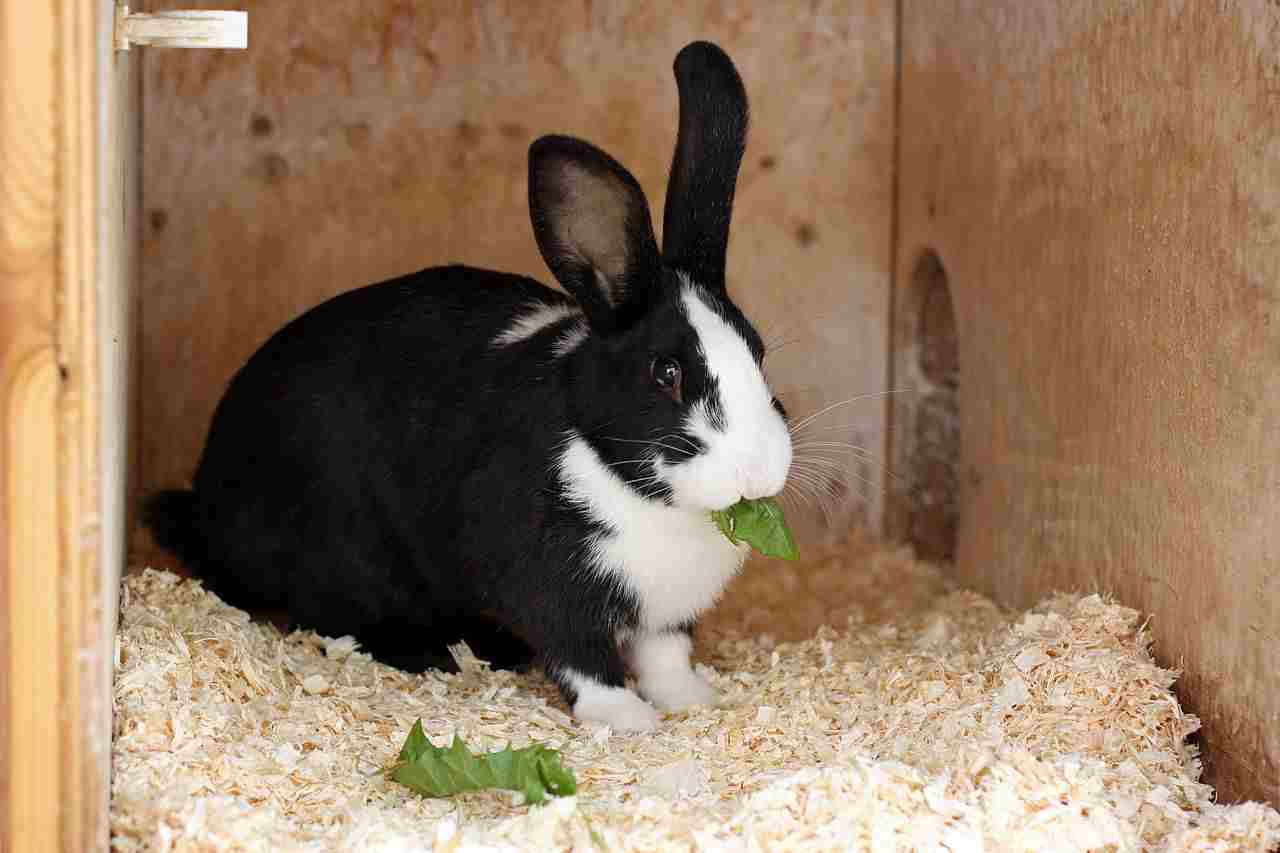
5. Collecting Fallen Branches and Twigs
Collecting fallen branches and twigs is not only a practical way to clean up your yard, but it can also be beneficial for wild rabbits during the winter months. By gathering these natural materials, you can create piles that serve as both insulation and a source of food for rabbits.
During the winter, fallen branches and twigs can provide rabbits with much-needed shelter and protection from the cold. By collecting and piling them up in strategic areas, you can create small havens where rabbits can seek refuge. These piles act as natural barriers against the harsh elements, helping to keep the rabbits warm and safe.
In addition to providing shelter, fallen branches and twigs can also serve as a food source for rabbits. Rabbits are herbivores and rely on a diet of vegetation, including bark and twigs. By collecting fallen branches and twigs and placing them near the rabbit shelters or feeding areas, you can ensure that the rabbits have access to a natural food source. This reduces their need to venture out in search of food, minimizing their exposure to predators and the risks associated with harsh weather conditions.
Collecting fallen branches and twigs is a simple and effective way to support wild rabbits during the winter. It not only helps to create insulation and food sources but also contributes to maintaining a healthy ecosystem. By taking the time to gather these natural materials, you can make a positive impact on the survival and well-being of wild rabbits in your area.
6. Providing Fruits and Pellets
Another way to help wild rabbits in winter is by providing them with fruits and pellets. While not as ideal as hay, these food options can still be beneficial for rabbits during the colder months.
Fruits, such as apples and pears, can be left where accessible to wild rabbits. These natural treats provide rabbits with essential vitamins and nutrients, helping to supplement their diet. By placing fruits in areas where rabbits frequent, you can offer them a tasty and nutritious snack that can help sustain them through the winter.
Pellets are another option to consider. These specially formulated rabbit food pellets are designed to provide a balanced diet for rabbits. They contain a mix of essential nutrients, including fiber, protein, and vitamins. Pellets can be scattered in areas where rabbits gather, ensuring they have access to a consistent source of nutrition.
While fruits and pellets can be helpful, it’s important to note that they should not replace the rabbits’ natural diet. Hay remains the best option for wild rabbits, as it closely mimics their natural foraging behavior and provides the necessary fiber for their digestive system. Fruits and pellets should be seen as supplementary food sources, especially during times when natural vegetation is scarce.
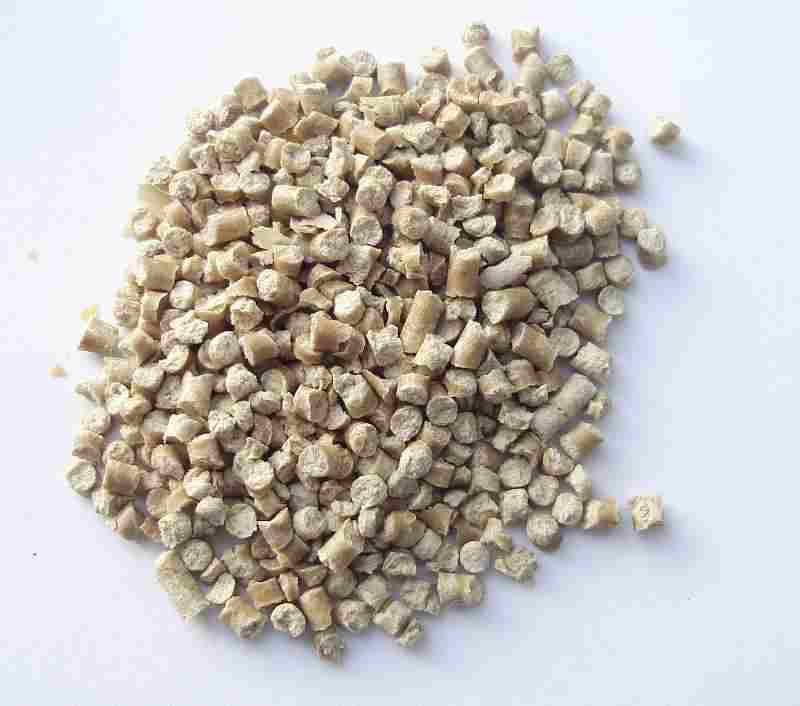
Rabbits Pellets are a Good Food Source
What Do Rabbits Eat in the Desert?
What rabbits eat in the desert goes beyond just forbs and grasses. These resilient creatures have adapted to their harsh environment and have learned to find sustenance in a variety of food sources. In addition to forbs and grasses, rabbits in the desert also consume succulents like cactus, as well as the leaves of mesquite trees and shrubs. They are resourceful eaters and can even feed on fallen fruits, mesquite bean pods, and the bark from desert trees and shrubbery.
The diverse diet of desert rabbits provides them with essential nutrients and hydration. Forbs and grasses offer a good source of carbohydrates and fiber, which are important for their energy and digestive health. Succulents like cactus provide rabbits with water, as these plants store moisture in their fleshy leaves and stems. Mesquite leaves and bark contain valuable minerals and vitamins that contribute to the overall health of desert rabbits.
The availability of food for desert rabbits can vary throughout the year due to seasonal changes. During the spring and summer months, when rainfall is more abundant, the desert landscape becomes more lush, and a greater variety of plants are available for rabbits to eat. This includes an increase in the availability of forbs, grasses, and succulents. As the seasons transition into fall and winter, the desert becomes drier, and the food sources for rabbits become more limited. However, rabbits have adapted to these changes and are able to survive on the resources that are still available to them.
In order to cope with the scarcity of food during the winter months, desert rabbits have developed survival strategies. They may rely more heavily on the bark of desert trees and shrubs, as well as the fallen fruits and mesquite bean pods that remain on the ground. These food sources provide rabbits with the necessary sustenance to endure the harsh desert conditions until the arrival of spring brings new growth and a wider variety of food options.
What Do Desert Cottontails Eat?
Desert cottontails have a diet that is similar to other rabbit species. They primarily eat grasses, which provide them with the necessary carbohydrates and fiber for energy and digestion. In addition to grasses, desert cottontails also consume forbs, sedges, and mesquite peas. These plants offer a variety of nutrients and contribute to the overall health of the rabbits.
During different seasons, the availability of food for desert cottontails can vary. In the spring and summer months, when rainfall is more abundant, there is a greater variety of plants for the rabbits to eat. This includes an increase in the availability of grasses, forbs, and other vegetation. However, as the seasons transition into fall and winter, the desert becomes drier, and the food sources for the rabbits become more limited.
To cope with the scarcity of food during the winter months, desert cottontails have developed survival strategies. They may rely more heavily on the bark of desert trees and shrubs, as well as fallen fruits and exposed roots. These food sources provide the necessary sustenance for the rabbits to endure the harsh desert conditions until the arrival of spring brings new growth and a wider variety of food options.
FAQs
1. What Do Rabbits Eat in the Forest?
Rabbits in the forest have a varied diet consisting of bark, fallen fruits, twigs, pine needles, shrub foliage, nuts, and seeds. They rely on these food sources to survive in their natural habitat.
In the forest, rabbits primarily feed on the bark of trees, especially during the winter months when other food sources may be scarce. They also consume fallen fruits, such as berries and apples, which provide them with essential nutrients. Twigs and pine needles are another important part of their diet, as they help to wear down their continuously growing teeth.
Additionally, rabbits in the forest feed on shrub foliage, which includes leaves and stems from various plants. This provides them with a good source of fiber. Nuts and seeds are also part of their diet, offering them additional energy and nutrients.
2. What Do Wild Rabbits Eat in Arizona?
In Arizona, wild rabbits have a diverse diet that includes prickly pear, twigs, fruit, and bark. These food sources are essential for their survival in the arid desert environment.
Prickly pear cactus pads and fruits are a common food source for wild rabbits in Arizona. They provide hydration and essential nutrients, helping rabbits to stay hydrated in the dry climate. Twigs and bark are also important components of their diet, as they help wear down their continuously growing teeth.
Wild rabbits in Arizona also consume a variety of fruits, such as berries and apples, when available. These fruits provide them with additional nutrients and energy. However, it’s important to note that their diet may vary depending on the specific region and availability of food sources.
3. Where Do Desert Cottontails Live?
Desert cottontails, also known as Sylvilagus audubonii, are small mammals that are native to the southwestern United States and northern Mexico. They are primarily found in arid desert regions, such as the Sonoran and Chihuahuan Deserts. These rabbits have adapted to live in a variety of habitats within these desert regions, including grasslands, shrublands, and desert scrub.
Desert cottontails typically live in areas with vegetation, such as mesquite, cacti, and other desert plants, as they provide cover and food sources. They are also known to inhabit areas near water sources, such as streams or springs, as water is essential for their survival in the desert environment.
These rabbits are highly adaptable and can be found in both rural and urban areas. They are often seen in residential neighborhoods, parks, and golf courses, where they can find suitable food and shelter. Desert cottontails are known for their ability to burrow, and they create shallow burrows in the ground to escape predators and seek shelter from extreme temperatures.
4. How Do Rabbits Survive the Winter?
Rabbits have several adaptations that help them survive the winter. Firstly, their fur becomes thicker and denser, providing better insulation against the cold. This helps them retain body heat and stay warm. Secondly, rabbits have the ability to dig burrows, which serve as shelters from harsh weather conditions.
These burrows provide protection from the cold, wind, and predators. Additionally, rabbits have a unique digestive system that allows them to extract more nutrients from their food. This helps them maintain their energy levels during the winter when food sources are scarce.
Lastly, rabbits are known to form groups or colonies during the winter, which provides them with safety in numbers and increases their chances of survival. By utilizing these adaptations, rabbits are able to endure the challenges of winter and thrive in their natural habitats.
5. Do Rabbits Go Off Their Food in Winter?
During the winter, rabbits may experience a decrease in appetite, but they do not completely go off their food. Their food preferences may change, as they rely more on woody plants and bark when fresh greens are scarce.
Rabbits have a unique digestive system that allows them to extract more nutrients from their food, which helps them maintain their energy levels during the winter months. It is important to provide rabbits with a balanced diet that includes hay, fresh vegetables, and a limited amount of pellets. This ensures they receive the necessary nutrients to stay healthy and warm during the colder months.
Additionally, providing fresh water is crucial, as rabbits still need to stay hydrated even in winter. By understanding their dietary needs and making appropriate adjustments, you can help rabbits thrive throughout the winter season.
6. What is the Best Food for Rabbits?
When it comes to the best food for rabbits, a balanced diet is key. Hay should make up the majority of their diet, as it provides essential fiber for their digestive system. Fresh vegetables, such as leafy greens and carrots, should also be included to provide additional nutrients. Pellets can be given in moderation, but they should be high-quality and specifically formulated for rabbits.
It’s important to avoid feeding rabbits foods that are high in sugar or starch, as these can lead to digestive issues. Additionally, rabbits should always have access to fresh water to stay hydrated. By providing a varied and nutritious diet, you can ensure that your rabbits stay healthy and happy throughout the year.
7. Do Rabbits Need Anything in the Winter?
In the winter, rabbits have specific needs to ensure their survival. One important requirement is shelter. Rabbits need a safe and warm place to protect themselves from harsh weather conditions, such as snow and freezing temperatures. Providing them with a cozy hutch or insulated shelter can help keep them comfortable during the winter months.
Another essential need for rabbits in winter is food. While their diet may change slightly, rabbits still require a balanced and nutritious diet to stay healthy. Hay should remain a staple in their diet, as it provides essential fiber. Additionally, fresh vegetables, such as kale and broccoli, can be offered to provide necessary nutrients.
By addressing these needs, rabbits can thrive during the winter season. Providing them with proper shelter and a well-rounded diet will ensure their well-being and help them stay strong throughout the colder months.
8. Do Rabbits Store Food for the Winter?
Rabbits do not store food for the winter. Unlike some other animals, such as squirrels, rabbits do not have the ability to hoard and store food for later use. Instead, they rely on finding food sources throughout the winter months. This is why it’s important to provide rabbits with a well-rounded diet during this time, as their food options may be limited in the wild.
By offering them a variety of fresh vegetables and high-quality hay, you can help ensure that they have access to the nutrients they need to stay healthy and strong. Additionally, providing a sheltered area with ample food and water can help attract rabbits to your yard, giving them a reliable food source during the winter.
9. Should I Feed Wild Rabbits in Winter?
Feeding wild rabbits in winter can be a controversial topic. While it may seem like a kind gesture, there are some important considerations to keep in mind.
Firstly, wild rabbits are adapted to finding their own food sources in the wild. Feeding them can disrupt their natural foraging behaviors and potentially lead to dependency on human-provided food.
Secondly, providing food for wild rabbits can attract other animals, such as rodents or predators, to your yard. This can create an imbalance in the local ecosystem and potentially cause harm to other wildlife.
If you are concerned about the well-being of wild rabbits in winter, a better approach is to create a rabbit-friendly habitat. This includes planting native vegetation, providing shelter, and ensuring a water source is available. By doing so, you can support their natural foraging behaviors and help them survive the winter without relying on human intervention.
10. What to Feed Wild Rabbits in Winter?
Feeding wild rabbits in winter is a common concern for many people. It’s important to provide them with the right food to help them survive the harsh conditions.
In winter, wild rabbits rely on a diet that is high in fiber and nutrients. This includes hay, fresh vegetables, and a small amount of pellets. Hay is especially important as it helps to keep their digestive system healthy and prevents dental problems. Fresh vegetables like carrots, kale, and broccoli provide essential vitamins and minerals. Pellets should only be given in small quantities as they can be high in calories and lead to obesity.
It’s also crucial to ensure that the food is easily accessible for the rabbits. Placing it in a sheltered area can protect it from snow and other elements. Additionally, providing fresh water is essential as rabbits need to stay hydrated even in winter.
Remember, it’s best to avoid feeding wild rabbits processed or sugary foods as they can be harmful to their health. By providing a balanced diet of hay, fresh vegetables, and a small amount of pellets, you can help wild rabbits stay healthy and strong throughout the winter season.
11. What Do Rabbits Do in the Winter?
During the winter months, rabbits have to adapt to the cold weather and limited food availability. They employ various strategies to survive and stay warm.
One of the main things rabbits do in the winter is seek shelter. They find cozy spots in burrows, brush piles, or under dense vegetation to protect themselves from the harsh elements. These shelters provide insulation and help them conserve body heat.
Rabbits also reduce their activity levels in the winter. They tend to stay hidden during the day and become more active at dawn and dusk when it’s slightly warmer. This conserves energy and helps them survive when food is scarce.
To stay warm, rabbits have a unique adaptation called “thermal regulation.” They can adjust their body temperature by increasing or decreasing blood flow to their ears and extremities. By reducing blood flow to these areas, they minimize heat loss and keep their core body temperature stable.
In terms of food, rabbits rely on stored fat reserves and the limited vegetation available during winter. They may nibble on bark, twigs, and buds when fresh greens are scarce. However, their diet becomes more restricted, and they rely on their fat stores to sustain them until spring when food sources become abundant again.
12. What do Rabbits Eat in the Wild?
Rabbits in the wild have a varied diet that consists mainly of grasses, leaves, and twigs. They are herbivores, which means they only eat plant material. In the wild, rabbits have to forage for their food, so they rely on finding a variety of plants to meet their nutritional needs. They eat different types of grasses, including clover, ryegrass, and fescue.
Rabbits also consume a variety of leaves from plants such as dandelions, plantain, and chickweed. They may also nibble on twigs and bark from trees and shrubs. It’s important for wild rabbits to have access to a diverse range of vegetation to ensure they get all the necessary nutrients. This is especially crucial during the winter months when food sources are limited.
13. What Vegetables Do Wild Rabbits Eat?
Wild rabbits have a diverse diet that includes a variety of vegetables. They rely on these vegetables to supplement their nutritional needs and maintain a balanced diet. Some of the vegetables that wild rabbits eat include carrots, lettuce, kale, spinach, and broccoli. These vegetables provide essential vitamins and minerals that are necessary for their overall health and well-being.
Additionally, wild rabbits may also consume other leafy greens such as dandelion greens, mustard greens, and collard greens. These greens offer additional nutrients and help to keep the rabbits hydrated. It’s important to note that while wild rabbits do eat vegetables, they primarily rely on grasses and other plant materials for their sustenance. The inclusion of vegetables in their diet is a supplement rather than a primary food source.
14. Do Rabbits Hibernate?
No, rabbits do not hibernate. Unlike some other animals, rabbits are active throughout the year, including during the winter. They have adapted to survive in cold temperatures by growing a thicker coat and seeking shelter in burrows or other protected areas.
During the winter, rabbits rely on their ability to find food in their environment. While their diet may change slightly due to the availability of certain plants, rabbits continue to eat and forage for food. They primarily feed on grasses, twigs, and bark, which provide them with the necessary nutrients to stay healthy and maintain their energy levels.
15. What Do Young Wild Rabbits Eat?
Young wild rabbits have specific dietary needs to support their growth and development. They rely on their mother’s milk for the first few weeks of their lives, which provides them with essential nutrients and antibodies. As they grow older, young rabbits start to nibble on solid foods.
Their diet consists mainly of tender grasses, herbs, and leafy greens. These provide them with the necessary fiber, vitamins, and minerals for healthy growth. Young rabbits also eat small amounts of twigs and bark to help wear down their constantly growing teeth.
16. What Vegetables Do Wild Rabbits Not Eat?
While wild rabbits have a diverse diet, there are certain vegetables that they tend to avoid. One vegetable that wild rabbits typically do not eat is onions. Onions contain compounds that can be harmful to rabbits and may cause digestive issues. Another vegetable that rabbits tend to avoid is potatoes. Raw potatoes contain solanine, a toxic substance that can be harmful to rabbits if consumed in large quantities.
Additionally, rabbits generally do not eat rhubarb, as it contains oxalic acid, which can be toxic to them. It’s important to note that while these vegetables are not typically consumed by wild rabbits, domesticated rabbits may have different dietary preferences. Always consult with a veterinarian or rabbit expert for specific dietary recommendations for your pet rabbit.
17. Where Do Rabbits Go in the Snow?
When the snow covers the ground, rabbits have a few strategies to cope with the cold weather. One common behavior is burrowing into the snow to create tunnels and shelters. These tunnels provide insulation and protection from the harsh elements. Rabbits also seek out dense vegetation, such as thick bushes or shrubs, which can provide additional cover from the snow and wind.
Another option for rabbits is to find existing burrows or dens, such as those made by other animals like foxes or groundhogs. These burrows offer a ready-made shelter that rabbits can use to stay warm and safe during the winter months.
18. How Do Wild Rabbits Survive the Winter?
Wild rabbits have several strategies to survive the harsh winter conditions. One key method is to adapt their behavior and habits. They will often change their feeding patterns, focusing on high-energy foods to sustain themselves during the cold months. Additionally, wild rabbits have the ability to grow a thicker coat of fur, which provides insulation and helps them retain body heat.
Another survival technique is seeking shelter in burrows or dens. Rabbits will find or create underground tunnels and chambers to protect themselves from the freezing temperatures and strong winds. These burrows offer a safe and warm environment where rabbits can conserve energy and stay protected from predators.
By combining these strategies, wild rabbits are able to endure the winter and increase their chances of survival until the arrival of spring.
19. How Can I Help My Wild Rabbit?
If you come across a wild rabbit during the winter months, there are a few ways you can provide assistance. Firstly, ensure that there is a source of fresh water available for the rabbit. This can be achieved by placing a shallow dish of water in a safe and accessible location. Additionally, you can create a sheltered area by placing a small box or pile of leaves near the rabbit’s habitat.
This will provide some protection from the elements. Remember to avoid feeding the rabbit, as their natural diet is best suited for their nutritional needs. By providing these simple accommodations, you can help wild rabbits survive the winter and increase their chances of thriving until spring arrives.
20. How Do You Take Care of Rabbits in the Winter?
Taking care of rabbits in the winter requires special considerations to ensure their health and well-being. Provide them with a warm and insulated shelter, such as a hutch or shed, with plenty of bedding and straw for insulation. Make sure the shelter is well-ventilated to prevent condensation and humidity.
Their diet should consist mainly of hay, which provides essential fiber and keeps their digestive system healthy. Supplement their diet with fresh vegetables like carrots, kale, and broccoli for important nutrients. Don’t forget to provide fresh water daily to prevent dehydration.
To keep rabbits active and stimulated, give them toys and objects to chew on. This helps prevent boredom and keeps their teeth healthy. Monitor their health closely for signs of illness or discomfort, such as loss of appetite or lethargy, and consult a veterinarian if needed.
By following these guidelines, you can ensure that your rabbits stay healthy and happy throughout the winter season. Provide them with a warm shelter, a balanced diet, and mental stimulation to thrive during the colder months.
21. What is the Best Food for Wild Rabbits?
Wild rabbits have specific dietary needs, especially during the winter months.
The best food for wild rabbits includes a variety of fresh greens, such as dandelion leaves, clover, and grass. These provide essential nutrients and hydration. Additionally, hay is a crucial part of their diet as it aids in digestion and keeps their teeth healthy.
It’s important to avoid feeding them foods high in sugar or carbohydrates, as these can cause digestive issues. Providing a diverse range of vegetation ensures that wild rabbits receive a balanced diet and stay healthy throughout the winter.
22. What Can I Feed Wild Rabbits in the Winter Time
In the winter time, it’s important to provide wild rabbits with a suitable diet to help them survive the cold weather. Fresh greens, such as kale and spinach, are excellent options as they provide essential nutrients. Additionally, hay should be available to them as it aids in digestion and keeps their teeth healthy.
23. What Vegetables do Wild Rabbits Eat?
Wild rabbits have a varied diet that includes a range of vegetables. Some of the vegetables that wild rabbits eat include carrots, lettuce, kale, spinach, and broccoli. These vegetables provide essential nutrients and fiber that help to keep the rabbits healthy.
It’s important to note that while wild rabbits can eat these vegetables, they should be given in moderation to avoid digestive issues. Additionally, it’s best to offer a mix of different vegetables to ensure a balanced diet for the rabbits.
24. What Human Food Can You Feed Wild Rabbits?
Wild rabbits can also eat certain types of human food. Some safe options include apples, bananas, and strawberries. These fruits provide natural sugars and vitamins that can be beneficial for the rabbits. However, it’s important to remember that these foods should only be given as occasional treats and not as a regular part of their diet.
Additionally, it’s crucial to avoid feeding them any processed or sugary foods, as these can be harmful to their health. Always consult with a wildlife expert or veterinarian before introducing any new foods to wild rabbits.
25. What Can You Feed Wild Rabbit Babies?
When it comes to feeding baby wild rabbits, it’s important to provide them with a diet that meets their specific nutritional needs. A suitable diet for baby rabbits includes fresh grass, hay, and leafy greens such as lettuce and spinach. It’s also important to provide them with a small amount of pellets specifically formulated for young rabbits.
Additionally, make sure to provide them with fresh water at all times. Avoid feeding them fruits or vegetables until they are older, as their digestive systems are not yet fully developed to handle these foods.
26. Do Wild Rabbits Eat Bird Seed?
When it comes to the diet of wild rabbits, bird seed is not a natural part of their food. Wild rabbits primarily feed on grass, hay, and leafy greens. These foods provide the necessary nutrients and fiber for their digestive system. Bird seed, on the other hand, is not suitable for rabbits as it is high in fat and lacks the essential nutrients they need.
Feeding wild rabbits bird seed can lead to digestive issues and obesity. It’s important to provide them with a diet that mimics their natural food sources to ensure their health and well-being. If you want to attract rabbits to your yard, consider planting rabbit-friendly vegetation or providing them with fresh grass and leafy greens. This will not only provide them with a suitable diet but also create a natural habitat for them to thrive in.
27. Do Wild Rabbits Eat Carrots?
While domesticated rabbits may enjoy carrots as a treat, wild rabbits have a different diet. In the wild, rabbits primarily feed on grass, hay, and leafy greens.
These foods provide the necessary nutrients and fiber for their digestive system. Carrots, on the other hand, are high in sugar and should only be given to wild rabbits in small quantities, if at all.
Feeding wild rabbits too many carrots can lead to digestive issues and obesity. It’s best to stick to their natural diet to ensure their health and well-being. If you want to attract wild rabbits to your yard, consider planting rabbit-friendly vegetation or providing them with fresh grass and leafy greens. This will create a natural habitat for them to thrive in.
28. Do Wild Rabbits Eat Apples?
While domesticated rabbits may enjoy apples as a treat, wild rabbits typically do not eat apples as part of their natural diet. Wild rabbits primarily feed on grass, hay, and leafy greens, which provide them with the necessary nutrients and fiber for their digestive system. Apples are high in sugar and can cause digestive issues for wild rabbits if consumed in large quantities.
It’s best to stick to their natural diet to ensure their health and well-being. If you want to attract wild rabbits to your yard, consider planting rabbit-friendly vegetation or providing them with fresh grass and leafy greens. This will create a natural habitat for them to thrive in.
29. What do Wild Brown Rabbits Eat?
Wild brown rabbits have a similar diet to other wild rabbits. They primarily eat grass, hay, and leafy greens.
These foods provide them with the necessary nutrients and fiber for their digestive system. Wild brown rabbits may also eat twigs, bark, and small branches to help wear down their teeth, which continuously grow.
It’s important to note that wild rabbits do not eat meat or animal products. By sticking to their natural diet, wild brown rabbits can maintain their health and well-being in their natural habitat.
30. Where do Wild Rabbits Sleep?
Wild rabbits create burrows or nests to sleep in. These burrows are usually located in areas with dense vegetation, such as thickets or brush piles. The burrows provide protection from predators and harsh weather conditions.
Rabbits are known for their digging abilities, and they create intricate tunnel systems underground. These tunnels have multiple entrances and exits, allowing the rabbits to escape quickly if needed. Inside the burrows, rabbits create cozy nests made of grass, leaves, and fur.
During the winter, wild rabbits may also seek shelter in other natural structures, such as hollow logs or dense shrubs. These locations provide additional protection from the cold.
31. Can You Feed Wild Rabbits Lettuce?
Lettuce is a popular vegetable, but can wild rabbits eat it? While lettuce is not toxic to rabbits, it is not an ideal food for them. Rabbits have sensitive digestive systems, and lettuce can cause digestive issues such as diarrhea.
In the wild, rabbits primarily eat grasses, weeds, and other leafy greens. These provide the necessary fiber and nutrients for their diet. Lettuce, on the other hand, has a high water content and lacks the necessary fiber.
If you want to feed wild rabbits, it’s best to stick to their natural diet. Offer them fresh grass, dandelion greens, or other leafy greens that are safe for rabbits. This will ensure they receive the proper nutrition without any negative side effects. Remember, it’s important to respect the natural diet of wild rabbits to keep them healthy and thriving.
32. What Kind of Rabbit Lives in the Desert?
Rabbits that live in the desert are typically those adapted for arid conditions, like the Desert Cottontail. These rabbits have specific adaptations that allow them to survive in the harsh desert environment.
Desert Cottontails have large ears that help them dissipate heat and regulate their body temperature. They also have long legs, which enable them to move quickly across the sandy terrain. Their fur is light in color, providing camouflage against the desert landscape.
In terms of diet, Desert Cottontails primarily eat grasses, shrubs, and cacti. They have the ability to extract moisture from their food, reducing their reliance on water sources. This adaptation allows them to thrive in areas with limited water availability.
33. What is a Wild Rabbit’s Favorite Food?
A wild rabbit’s favorite food can vary depending on its habitat and availability of food sources. In general, wild rabbits prefer to eat fresh grasses, herbs, and leafy greens. These provide them with the necessary nutrients and fiber for their diet.
They also enjoy nibbling on twigs, bark, and small branches to help wear down their constantly growing teeth. Wild rabbits have a keen sense of smell and can locate their favorite foods easily. Some of their preferred food options include clover, dandelion greens, plantain, and wildflowers. It’s important to note that while these are their favorites, wild rabbits are opportunistic eaters and will consume a variety of vegetation based on what is accessible in their environment.
34. What Kind of Rabbit Lives in the Desert?
In the desert, you may be surprised to find a specific type of rabbit known as the desert cottontail. This rabbit species has adapted to the harsh desert environment and can be found in arid regions of North America. The desert cottontail has several unique characteristics that help it survive in this challenging habitat.
Its sandy-brown fur provides camouflage, allowing it to blend in with the desert landscape. Additionally, the desert cottontail has large ears that help regulate its body temperature in the extreme heat. This rabbit primarily feeds on desert vegetation such as cacti, shrubs, and grasses. Despite the harsh conditions, the desert cottontail has managed to thrive and is an important part of the desert ecosystem.
35. What Desert Animal Eats a Rabbit?
In the desert, one of the animals that preys on rabbits is the kit fox. This small carnivorous mammal is native to North America and is well adapted to the harsh desert environment.
With its keen senses and agility, the kit fox is an efficient hunter. It primarily feeds on small mammals, including rabbits, mice, and ground squirrels. The kit fox uses its sharp teeth and claws to catch and kill its prey. Despite the challenges of finding food in the desert, the kit fox has evolved to be a skilled predator and plays an important role in maintaining the balance of the desert ecosystem.
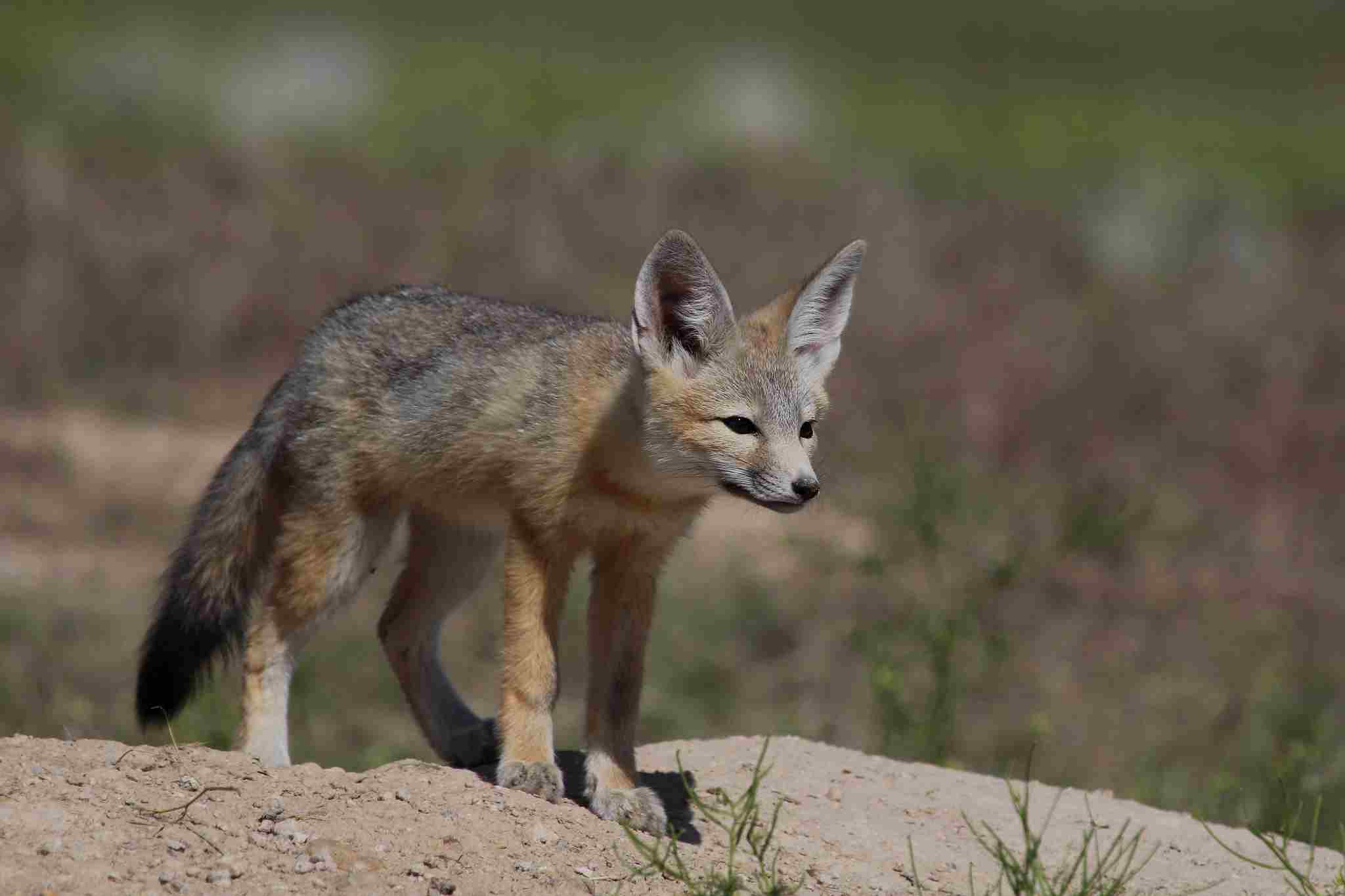
36. What is a Wild Rabbit’s Favorite Food?
Wild rabbits have a varied diet, but their favorite food is fresh green vegetation. They love to munch on grass, clover, and dandelion leaves. These leafy greens provide them with essential nutrients and hydration.
In addition to greens, wild rabbits also enjoy eating twigs, bark, and small branches. These woody materials help to wear down their constantly growing teeth.
Another favorite food of wild rabbits is hay. Hay is a dried grass that is rich in fiber and helps to keep their digestive system healthy.
While wild rabbits primarily rely on vegetation for their diet, they may also eat small amounts of fruits and vegetables when available. However, it’s important to note that their digestive system is not well-suited for high sugar or starchy foods, so these should only be given in moderation.
37. How Do Rabbits Survive in the Desert?
Rabbits have adapted to survive in the harsh desert environment through various strategies. Firstly, they have developed efficient water conservation mechanisms. Rabbits obtain most of their water from the plants they eat, and they have the ability to concentrate their urine to minimize water loss. Additionally, rabbits are crepuscular, meaning they are most active during dawn and dusk when temperatures are cooler. This helps them avoid the scorching heat of the day.
To protect themselves from predators and extreme temperatures, rabbits dig burrows in the sand. These burrows provide shelter from the intense heat and offer protection from predators. Rabbits also have large ears that help dissipate heat and regulate their body temperature.
In terms of food, desert rabbits have adapted to eat a variety of desert plants, including cacti, grasses, and shrubs. They have specialized digestive systems that allow them to extract as much moisture as possible from their food.
38. What does a Desert Cottontail Eat?
The Desert cottontail has a varied diet that consists mainly of plants. They are herbivores and primarily feed on grasses, shrubs, and cacti. Desert cottontails have adapted to survive in arid environments by consuming plants that are able to withstand the harsh conditions. They are known to eat a variety of desert plants, including sagebrush, mesquite, and prickly pear cactus. These plants provide the necessary nutrients and moisture for the rabbits to survive in the desert.
In addition to plants, Desert cottontails may also consume certain fruits and vegetables if they are available. They have been observed eating fruits such as berries and melons, as well as vegetables like carrots and lettuce. However, their diet primarily consists of native desert vegetation.
39. What Eats Rabbits in the Desert?
In the harsh desert environment, rabbits face numerous predators that rely on them as a food source. One of the main predators of rabbits in the desert is the coyote. These cunning canines are skilled hunters and have adapted to survive in the arid conditions. Other predators include bobcats, foxes, and birds of prey such as hawks and eagles.
These predators use their speed, agility, and keen senses to catch rabbits and make them a part of their diet. Snakes, such as rattlesnakes, also pose a threat to rabbits in the desert. These predators rely on their venomous bites to immobilize their prey. With such a diverse range of predators, rabbits in the desert must always be on high alert to ensure their survival.
40. Are There Rabbits in the Sahara Desert?
The Sahara Desert is known for its extreme heat and arid conditions, making it a challenging environment for most animals. However, there are indeed rodents like rabbits that can be found in the Sahara Desert. One such rabbit is the Cape hare, which is a close relative of the common rabbit.
The Cape hare has adapted to survive in the harsh desert climate by having long ears that help dissipate heat and a light-colored fur that provides camouflage against the sandy landscape. These rodents are primarily nocturnal, which allows them to avoid the scorching temperatures during the day. They feed on desert plants and have developed efficient water conservation mechanisms to survive in the desert’s limited water sources.
While the Sahara Desert may not be the ideal habitat for rabbits, the presence of the Cape hare demonstrates their ability to adapt and thrive in even the most challenging environments.
41. What Eats a Desert Cottontail?
The desert cottontail, a small mammal found in the desert regions of North America, is an important part of the food chain. Many predators rely on the desert cottontail as a source of food. One of the main predators of the desert cottontail is the coyote. Coyotes are skilled hunters and have adapted to the desert environment, making them efficient at catching and consuming desert cottontails.
Other predators include bobcats, foxes, and birds of prey such as hawks and owls. These animals have sharp claws, strong beaks, and keen eyesight, which help them capture and feed on desert cottontails. Additionally, snakes like rattlesnakes and bullsnakes also prey on desert cottontails. They use their venom or constriction to immobilize and consume their prey.
42. Where Does the Desert Cottontail Live?
The desert cottontail, a small mammal found in the desert regions of North America, has a wide range of habitats. It can be found in various desert ecosystems, including deserts, scrublands, and grasslands. This species is well adapted to survive in arid environments and can be found in states such as Arizona, California, Nevada, New Mexico, Texas, and Utah.
Desert cottontails prefer areas with dense vegetation, such as shrubs and cacti, which provide them with cover and food sources. They are also known to dig burrows in sandy or rocky soil for shelter and protection from predators and extreme temperatures. These burrows can be found in open areas or under vegetation.
43. Is the Desert Cottontail Endangered?
The Desert Cottontail is not currently listed as endangered (as 0f 2023), however its population is facing threats due to habitat loss and fragmentation.
Human activities such as urbanization, agriculture, and infrastructure development have resulted in the destruction and degradation of the desert ecosystems where the Desert Cottontail resides. This has led to a decline in their population and a decrease in suitable habitats. Additionally, the introduction of non-native species and the spread of diseases pose further challenges to their survival.



